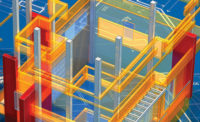We have had a tremendous shock to the health care system. There will, rightly, be hundreds of papers and studies looking at the issues of capacity, access and equity, public health, and our entire system of care. But the foremost need is a proactive and immediate response to infection control concerns that will be required to encourage patients to return to health care settings after the pandemic subsides.
The SmithGroup health care team is exploring several new safety concepts and their impact on the facility environment. These ideas are envisioned to work together to create a new, holistic model of care that enhances patient access, limits potential infection, and focuses on getting the health care system back on track while keeping patients and staff safe.
Technology
“Stay at home” has become a new mantra for health care. Out of necessity, providers and patients have embraced telehealth for stay-at-home care as never before, as barriers to adoption and reimbursement challenges have been eliminated. This short-term solution to manage during the COVID-19 crisis is also a long-term solution for improved patient access and reduced infection transmission. To effectively integrate telemedicine into the care model, a more strategic approach to planning and design will be needed to right-size facilities and limit overbuilding.
People and place
Technology, process, and facilities must work together. No-touch patient facility solutions and concepts necessitate environments and processes that will reduce or eliminate the need for patients and staff to physically contact furniture, fixtures, and devices.
Creating safe staff zones is imperative to reduce the risk of infection for caregivers. The current on-stage/off-stage concept for facility design is a start, but clean core working environments go a step further. This concept provides designated, no-patient-access staff areas (off-stage) that are supported by enhanced mechanical systems to provide a cleaner and safer environment. This will become especially critical as providers call on retired or physically compromised staff to address acute staff shortages.
Proactive planning
The time to plan and design for recovery is now. If we wait until the COVID-19 crisis is over, it will be too late to ensure facilities and operations can be adapted in time to welcome patients back and give patients and staff confidence that they’ll be safe from infection.
Never before has the industry had this singular opportunity to rethink how health care is provided. With the shutdown of most health care portals, now is the time to redefine how to reopen and enact meaningful change. Do we go back to business as normal or proactively seize this opportunity to discuss how to rebuild health care to embrace the next generation of challenges?





